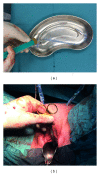Coating of mesh grafts for prolapse and urinary incontinence repair with autologous plasma: exploration stage of a surgical innovation
- PMID: 25313358
- PMCID: PMC4182302
- DOI: 10.1155/2014/296498
Coating of mesh grafts for prolapse and urinary incontinence repair with autologous plasma: exploration stage of a surgical innovation
Abstract
Purpose: Optimized biocompatibility is a major requirement for alloplastic materials currently applied for stress urinary incontinence (SUI) and pelvic organ prolapse (POP) repair. In the preliminary studies the mesh modification by coating with autologous plasma resulted in the increased adherence score in vitro and improved biocompatibility in an animal model. The first use of plasma coated meshes in human is presented.
Materials and methods: Between 04/2013 and 05/2014, 20 patients with the indication for SUI and POP repair were selected in a single institution. The applied meshes were modified by autologous plasma coating prior to implantation. A retrospective chart review for peri- and early postoperative complications was performed. Functional outcome and QoL were evaluated pre- and postoperatively.
Results: The functional outcome and QoL improved significantly in all groups. Two reoperations (Grade IIIB) with the release of TVT-mesh in anesthesia due to the obstruction were needed. No other severe complications were registered.
Conclusion: For the first time we applied a mesh modification in a human setting according to IDEAL criteria of surgical innovations. The procedure of mesh coating with autologous plasma is safe and a prospective randomized trial proving a positive effect of plasma coating on the biocompatibility and morbidity outcome with long-term registry is planned.
Figures


Similar articles
-
Consensus Statement of the European Urology Association and the European Urogynaecological Association on the Use of Implanted Materials for Treating Pelvic Organ Prolapse and Stress Urinary Incontinence.Eur Urol. 2017 Sep;72(3):424-431. doi: 10.1016/j.eururo.2017.03.048. Epub 2017 Apr 14. Eur Urol. 2017. PMID: 28413126 Review.
-
Minimum 1.5-year results of "surgeon-tailored" transvaginal mesh repair for female stress urinary incontinence and pelvic organ prolapse.Urology. 2012 Aug;80(2):273-9. doi: 10.1016/j.urology.2012.03.064. Urology. 2012. PMID: 22857745
-
[Study on concomitant surgical correction of pelvic organ prolapse and TVT-O for treatment of stress urinary incontinence].Zhonghua Fu Chan Ke Za Zhi. 2013 Jul;48(7):494-8. Zhonghua Fu Chan Ke Za Zhi. 2013. PMID: 24284218 Chinese.
-
Use of Concomitant Stress Incontinence Surgery at Time of Pelvic Organ Prolapse Surgery Since Release of the 2011 Notification on Serious Complications Associated with Transvaginal Mesh.J Urol. 2017 Apr;197(4):1092-1098. doi: 10.1016/j.juro.2016.11.087. Epub 2016 Nov 17. J Urol. 2017. PMID: 27866958
-
The challenge of stress incontinence and pelvic organ prolapse: revisiting biologic mesh materials.Curr Opin Urol. 2019 Jul;29(4):437-442. doi: 10.1097/MOU.0000000000000645. Curr Opin Urol. 2019. PMID: 31083010 Review.
Cited by
-
Histological response to platelet-rich plasma added to polypropylene mesh implemented in rabbits.Int Braz J Urol. 2016 Sep-Oct;42(5):993-998. doi: 10.1590/S1677-5538.IBJU.2015.0319. Int Braz J Urol. 2016. PMID: 27583354 Free PMC article.
-
Effect of the platelet-rich plasma covering of polypropylene mesh on oxidative stress, inflammation, and adhesions.Int Urogynecol J. 2020 Jan;31(1):139-147. doi: 10.1007/s00192-019-03938-5. Epub 2019 May 25. Int Urogynecol J. 2020. PMID: 31129689
-
Can platelet-rich plasma coating improve polypropylene mesh integration? An immunohistochemical analysis in rabbits.Int Braz J Urol. 2021 Mar-Apr;47(2):287-294. doi: 10.1590/S1677-5538.IBJU.2020.0017. Int Braz J Urol. 2021. PMID: 33146979 Free PMC article.
-
Effect of platelet-rich plasma on polypropylene meshes implanted in the rabbit vagina: histological analysis.Int Braz J Urol. 2017 Jul-Aug;43(4):746-752. doi: 10.1590/S1677-5538.IBJU.2016.0177. Int Braz J Urol. 2017. PMID: 27819759 Free PMC article.
-
Novel minimally invasive laser treatment of urinary incontinence in women.Lasers Surg Med. 2015 Nov;47(9):689-97. doi: 10.1002/lsm.22416. Epub 2015 Sep 21. Lasers Surg Med. 2015. PMID: 26388213 Free PMC article. Clinical Trial.
References
-
- UPDATE on Serious Complications Associated with Transvaginal Placement of Surgical Mesh for Pelvic Organ Prolapse: FDA Safety Communication. http://www.fda.gov/MedicalDevices/Safety/AlertsandNotices/ucm262435.htm. - PubMed
-
- Haylen BT, Freeman RM, Swift SE. An International Urogynecological Association (IUGA)/International Continence Society (ICS) joint terminology and classification of the complications related directly to the insertion of prostheses (meshes, implants, tapes) and grafts in female pelvic floor surgery. Neurourology and Urodynamics. 2011;30(1):2–12. - PubMed
-
- Amid PK, Lichtenstein IL. Current situation of the Lichtenstein open tension-free hernioplasty. Chirurg. 1997;68(10):959–964. - PubMed
-
- Barski D, Otto T, Gerullis H. Systematic review and classification of complications after anterior, posterior, apical, and total vaginal mesh implantation for prolapse repair. Surgical Technology International. 2014;24 - PubMed
-
- Maher C, Feiner B, Baessler K, Schmid C. Surgical management of pelvic organ prolapse in women. Cochrane Database of Systematic Reviews. 2013;(4)CD004014 - PubMed
MeSH terms
Substances
LinkOut - more resources
Full Text Sources
Other Literature Sources
Medical

